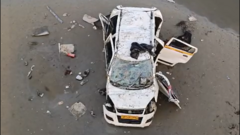On Sunday, three men tragically died when their car fell from an incomplete bridge into a riverbed in Uttar Pradesh while en route to a wedding. The incident has raised critical questions about the accountability of navigation apps, particularly Google Maps, which allegedly directed the men onto this hazardous route. Local authorities had previously closed off the bridge after part of it collapsed during floods, yet the newcomers were unaware due to a lack of barriers or signage.
In the aftermath, police filed a complaint against four engineers from the road department and an unnamed Google Maps official, citing culpable homicide. While Google has stated its commitment to cooperating with the ongoing investigation, this incident has spotlighted the significant shortcomings in India’s infrastructure and stirred a debate regarding the responsibility of digital navigational tools in ensuring public safety.
The case shines a light on the over-reliance on navigation applications, which many users have come to depend on for everyday travel. Google Maps is the most utilized navigation platform in India, boasting around 60 million active users and processing an average of 50 million searches daily. However, it has a history of providing misleading directions, culminating in various fatal incidents, including a case from Maharashtra in 2021 where a driver drowned after following app instructions into a dam.
Experts highlight that while GPS navigation apps use signals from users to update traffic conditions, they lack a robust mechanism for real-time infrastructure updates, making accountability complex. Ashish Nair, former Google Maps employee, posits that while users must exercise their judgment on the road, apps cannot continuously update every road's status, especially in a diverse and rapidly evolving country like India.
The absence of a systematic process for logging infrastructure changes further complicates matters. Unlike some countries with efficient reporting systems, India suffers from significant data gaps that impede timely updates for navigation apps. As lawyers weigh in on the legal implications, the consensus suggests that while these platforms are historically regarded as intermediaries with limited liability, they could face scrutiny if proven negligent in updating important data. Until proactive measures for data collection and sharing are implemented by authorities, users might continue facing risks associated with faulty mapping.
The incident serves as a sobering reminder of the intersection between technology and safety, urging a re-evaluation of how reliance on digital tools can sometimes lead to tragic outcomes.
In the aftermath, police filed a complaint against four engineers from the road department and an unnamed Google Maps official, citing culpable homicide. While Google has stated its commitment to cooperating with the ongoing investigation, this incident has spotlighted the significant shortcomings in India’s infrastructure and stirred a debate regarding the responsibility of digital navigational tools in ensuring public safety.
The case shines a light on the over-reliance on navigation applications, which many users have come to depend on for everyday travel. Google Maps is the most utilized navigation platform in India, boasting around 60 million active users and processing an average of 50 million searches daily. However, it has a history of providing misleading directions, culminating in various fatal incidents, including a case from Maharashtra in 2021 where a driver drowned after following app instructions into a dam.
Experts highlight that while GPS navigation apps use signals from users to update traffic conditions, they lack a robust mechanism for real-time infrastructure updates, making accountability complex. Ashish Nair, former Google Maps employee, posits that while users must exercise their judgment on the road, apps cannot continuously update every road's status, especially in a diverse and rapidly evolving country like India.
The absence of a systematic process for logging infrastructure changes further complicates matters. Unlike some countries with efficient reporting systems, India suffers from significant data gaps that impede timely updates for navigation apps. As lawyers weigh in on the legal implications, the consensus suggests that while these platforms are historically regarded as intermediaries with limited liability, they could face scrutiny if proven negligent in updating important data. Until proactive measures for data collection and sharing are implemented by authorities, users might continue facing risks associated with faulty mapping.
The incident serves as a sobering reminder of the intersection between technology and safety, urging a re-evaluation of how reliance on digital tools can sometimes lead to tragic outcomes.




















